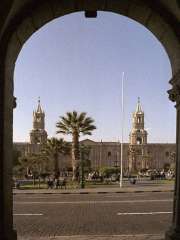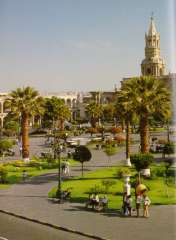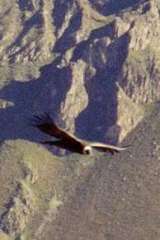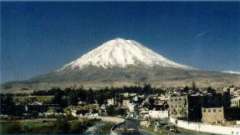| PLAZA DE ARMAS ( MAIN SQUARE ) & CATEDRAL Surrounded by the Cathedral and various impressive portals, Plaza de Armas presents a beautiful bronze fountain of three plates crowned with the figure of a soldier of the sixteenth century. To this character is called the “Tuturutu”. Around the square you can see three portals made granite and brick vaults and lime: the Cabildo Portal (Portal Municipality), the Portal de las Delicias (Portal de San Agustin) and the Portal Rejoicing (Portal de Flores).The Cathedral It is considered one of the first sights century religious XVII in the city. It built in sillar (volcanic stone) with brick vaults, Has real jewels in pictures, sculptures and oil paintings of famous artists. Its main altar is made of marble from Carrara (Italy), the wooden pulpit is a French beauty that was carved by the artist Rigot and its body structure was manufactured in Belgium. Counting with a complete museum of religious art.Visit the Cathedral: Monday to Saturdays 7:00-11:30 and 17:00-19:30; Sundays 7:00- 13:00 y 17:00-19:00. |
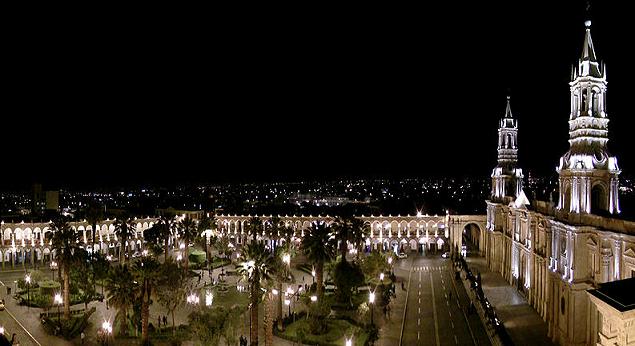 |
|
Once in the city, the Plaza de Armas, the ‘La Compañia de Jesus’ church, which has cloisters with ashlar (volcanic white stone or ‘sillar”) arcades, and the renowned Santa Catalina Convent should not be missed. On the outskirts of: the city some districts stand out because of their beauty, like Cayma, which temple was built in 1730, or Yanahuara, which belvedere offers a great view of the city surrounded by volcanoes, such as Cachani, 1,076 meters (3,529 feet) a.s.l. |
|
MEJIA LAGOONS
The Mejia Lagoons National Sanctuary is located on the coast of Arequipa, near the mouth of the Tambo river, 20 km (12.4 miles) south of the port of Mollendo and 150 krn (93 miles) from the city.
|
|
It is an isolated ecosystem and the only vestige, between the north of Chile and Pisco, of the ancient flooded lands that were part of the American coast, drained for agriculture for centuries. In spite of being located at sea level and 170 S latitude, the annual average temperature in the Mejía Lagoons is usually 18º C (64.40 F), under the effect of the Peruvian (Humboldt) warm stream. |
AGUADA BLANCA AND SALINAS
Behind the Misti volcano, as seen from the city, over an extensive plain at 4,000 meters (13,120 feet) a.s.l. is the Aguada Blanca dam, declared a National Reserve. It is a rather shallow and artificial lake originated by the Blanco river containment. A little to the south, behind the Pichu Pichu peak, is an even larger lagoon called Salinas. These lagoons are a place for resting and nesting for a large population of birds like the colorful flamingos. There is a strong migratory relationship between these birds and the ones from Mejía, 180 km (111.6 miles) from Salinas.
PAMPA CAÑAHUAS
Located at the Aguada Blanca National Reserve, behind the Chachani peak. At about 4,000 meters (13,120 feet) a.s.I. this larger plain represents one of the best habitats for the protection of vicuñas. a Peruvian camelid, internationally known for its fine fleece. In Pampa Cañahuas, these animals can be seen running completely free and, therefore, without the shyness and apathy that seems to characterize them under captivity.
To the north of Arequipa is the higher course of the Colca river valley which deep canyon is renowned among rafters. The section previous to the canyon consists of an encased valley that runs from east to west, beginning in the cold puna and running down to warmer regions, showing its great scenic beauty and cultural attractiveness.
Colca Valley, in the villages of this valley one can see beautiful scenery and plenty of terraces and colonial architectural monuments, surrounded by a variety of platforms which are inhabited by descendants of the ancient collaguas and cabins. In this region is situated the Famous Colca Canyon.
This Impressive Canyon Is located 148 km northeast of Arequipa (caylloma province). The Colca Canyon is known as one of the deepest of the earth, with special attractions such as vicuña, condor sanctuary, hot springs and terraces, among other; formed by the river of the same name where you can practice several activities of adventure sports such as rafting, boating, canoes, kayaks and paragliding. Count with 14 colorful Andean villages spread over the valley.
In addition you’ll have great views of the smoking Sabancaya volcano, one of the America’s most active volcanoes, as well seeing the many traditional pre-Inca agricultural terraces which line the steep valley sides. Also other representative point of this stunning site is that you can be able to visit La Cruz Del Condor (3320m), a 1½ hours from Chivay, From this natural observatory you can observe into the deepest part of the canyon, and be witness of the majestic flight of the Andean Condor, rising on the morning thermals (at around 9am.)
COLCAS
One of the survival skills of the ancient Colca people was the ability to store large amounts of grain for hard times the warehouses, known as ‘colcas’, gave name to the valley. In the ‘cool’ caves of Pumunuta, it is possible to see circular colcas a meter (3.28 feet) in diameter, mad of mud and straw.
|
|
CRUZ DEL CONDOR |
RAFTING ALONG THE COLCA-MAJES RIVER
From December to March, expert and trained rafters can go along the high and middle section of the river, explored by the 1979 Polish expeditions. It includes very difficult and isolated rapids, as the towns are far from the torrent. Although the low section may be ran over in rubber rafts, only expert people, trained in kayac rafting can do it in the canyon sections.
The name of the Colca river changes as it flows down to the Pacific ocean, Past the canyon; its name is Majes. Here, there are more chances for tourists to go in rubber rafts. The chances of finding shelters and access ways are better. Although its navigable section (Andamayo-Aplao river) does not have long rapids, the beauty of landscape and the clean river course allows enjoying the comfortable trip. The area is open year round to visitors.
ETHNIC RICHNESS
An ethnic group, bearer of ancient and still strong traditions, has dwelled the valley for more than 2,000 years. They are the Collaguas who arrived to the Colca valley from the high regions and seem to be descendants of the Aymaras because of their language and customs. Even under the Inca dominion, they kept themselves relatively Independent, and preserved their own traditions. It is sold that the supreme Inca Mayta Capac married a Collagua princess in order to formalize the conquest of the valley, and he built for her an elegant country house made of copper, near Sibayo.
PETROGLYPS
The early settlers of the valley left their own peculiar trace in petroglyphs such as Sumbay and Toro Muerto. Dancers with bizarre headdresses, different mammals, condors, and lines of unbreakable codes encompass the repertory of vast figures.
CHURCHES
There are almost 20 towns along the valley, which people preserve the ethnic richness of their past more than any other region of the country. The main ones are Chivay, Cabanaconde, Huambo, Maca, Achoma, Yunque, Larl and Coporaque, all very religious towns, whose Catholic faith also keeps alive pre-Columbian elements. Each town has its own church, bearer of its Hispanic and an example of architectural sobriety and purity based on the ashlar stone.
VALLEY OF THE VOLCANOES
Entering the -so called- ‘Valley of the Volcanoes” of Andagua means going back several geological eras to witness some outstanding phenomena that only happen in two places In the world: the Canary Islands and In this Arequipa valley.
|
The Andagua river valley runs along the foothill of the great Coropuna volcano, the highest in Peru and the tenth highest in South America. Geothermal activity In this area has given birth to about 80 volcanoes, all of them extinct which give this area a moonlike aspect. Later, the Andagua river disappears in a 17 km (10.5 miles) stretch, running under the ground between the Chachas and the Mamacocho lagoons before flowing into the Colca. Andagua can be reached only by highway from the west. |
|
HOT SPRINGS
Because of the volcanic nature of the region, there is hot springs in different areas of the valley. The main ones are Yunque, Chivay, Callalli, La Calera, Huancarama, Yura and Jesus. Furthermore, these hot springs are frequently related to ‘puquiales”, natural sources of cold, extremely pure and 100% potable water.
Spectacular airplane flights are available allowing a unique and extraordinary view of the main attractions of Colca, that can only be seen from the air. There are landing strips in Huambo (in the canyon), Orcopampa (near the Volcano Valley), Coporaque (the high part of the valley), Tiabaya, near Arequipa and also from the city airport.
SANTA CATALINA CONVENT
Built with the main reason of give a shelter to the daughters of the most distinguished Families of the city, was Founded in September 1579 under the patronage of Saint Catherine of Siena, is the most important and impressive religious monument in Peru, which was closed to the world until 1970.
With an area of 20.426 m, preserves intact the characteristics of the sixteenth and seventeenth centuries, counting with narrow spaces, architecturally diverse features rooms which one of the rooms has been converted into a gallery to display some paintings from the Cuzco school, Arequipa and Quito. Then streets and gardens that relate with Spanish names, from the European cities of Seville and Granada. Have two important Museums that exhibit relics and religious ornaments. Count also with other rooms or areas to visit as the Cloister of the Goal, Pre-Columbian Museum, the Cloister of San Francisco, etc.
Santa Catalina 301. Open daily 9am – 5pm, last admission 4pm.
ANDEAN SANCTUARIES MUSEUMS
Is displayed at the Museum Sanctuary within a frozen glass container the body of The Lady of Ampato, the prehispanic mummy best preserved in the world that is popularly known as Juanita. Was found surrounded by valuable offerings such as ceramics and pieces of gold and silver and according to the investigators, would have been sacrificed to honor the snowy Ampato, when it was ruled by Tupac Yupanqui. There are also almost 20 other mummies discovered from Peru, Chile and even Argentina. The visitors will be able to see around the woodcarvings, gold works and textiles. The Andean Sanctuaries Museum was established in the Year 1996, following the important archaeological investigations conducted by the Project “Height Sanctuaries Southern Andes”.
Open: Monday to Saturday – 09:00 to 18:00, Sunday – 09:00 to 15:00
COTAHUASI CANYON
The Cotahuasi Canyon is located in the province of La Union, is The deepest and most beautiful, has a depth of 3535 meters, was declared National Tourist Reserved Zone in 1988, in recognition of its natural attractions, cultural and archaeological, also count with other canyons such as; Inchukilka, Palmadera and Sipia and impressive waterfalls like, Allankay, Sipia Huaccay. Then there are two wonderful rainbows, where you can appreciate the flight of the condors at the fullest.
According to several scientists of the National Geographic, was stated that Cotahuasi is a center of cosmic energy and magnetism.
MISTI VOLCANO
The Misti Volcano is essential and determinant scenery of beauty and the main feature that represented the department of Arequipa, It is located 17.5 km northeast of the city and you can reach the volcano (1 hour 30 minutes by car). From the top of its summit you can observe at its all splendor the city of Arequipa, the Chili River valley, and Chachani and Pichu Pichu.
Definitely climbing this volcano It is a unique experience that combines the exciting process of ascension to the full satisfaction of reaching the summit, exploring the crater and from there, to contemplate the fantastic view of the city of Arequipa and its surroundings.
